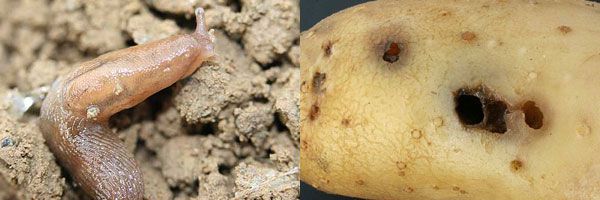
Arion hortensis & Deroceras reticulatum
(Slugs)
- Causal agent
Slugs belong to the phylum Mollusc (Gastropoda family) and their composition – over 85% water – makes them highly vulnerable to dessication in their environment. The behaviour of slugs is mainly nocturnal and is closely linked to the climatic conditions, mainly temperature and relative humidity.
Two main species of slugs are responsible for damage to potato tubers: the black slug and the grey slug.
The black slug, Arion hortensis (photos 1 and 2) measures 3 to 4 cm; it is blue- black in colour with an orange yellow ventral face, and the mucus is colourless. The body sides are dark and the tentacles, reddish. It preferably lives deep down in the soil and moves at a rate of 2 to 3 metres during a night. It can lay up to 150 to 300 eggs, mainly between spring and summer. It lives for between 12 and 18 months.
The grey slug, Deroceras reticulatum (photo 3), whose size ranges from 4 to 5 cm, is beige-grey in colour with reticulations in the form of elongated brown spots. Its mucus is milky white in colour. It preferably lives on the soil surface, and so covers greater distances (up to 7 metres during a night). The grey slug lays 300 to 400 eggs and very often produces two generations a year, in spring and in autumn.
- Significance
Many cultivated crops may be attacked by slugs: rape, straw cereals, maize, beetroot and also the potato.





